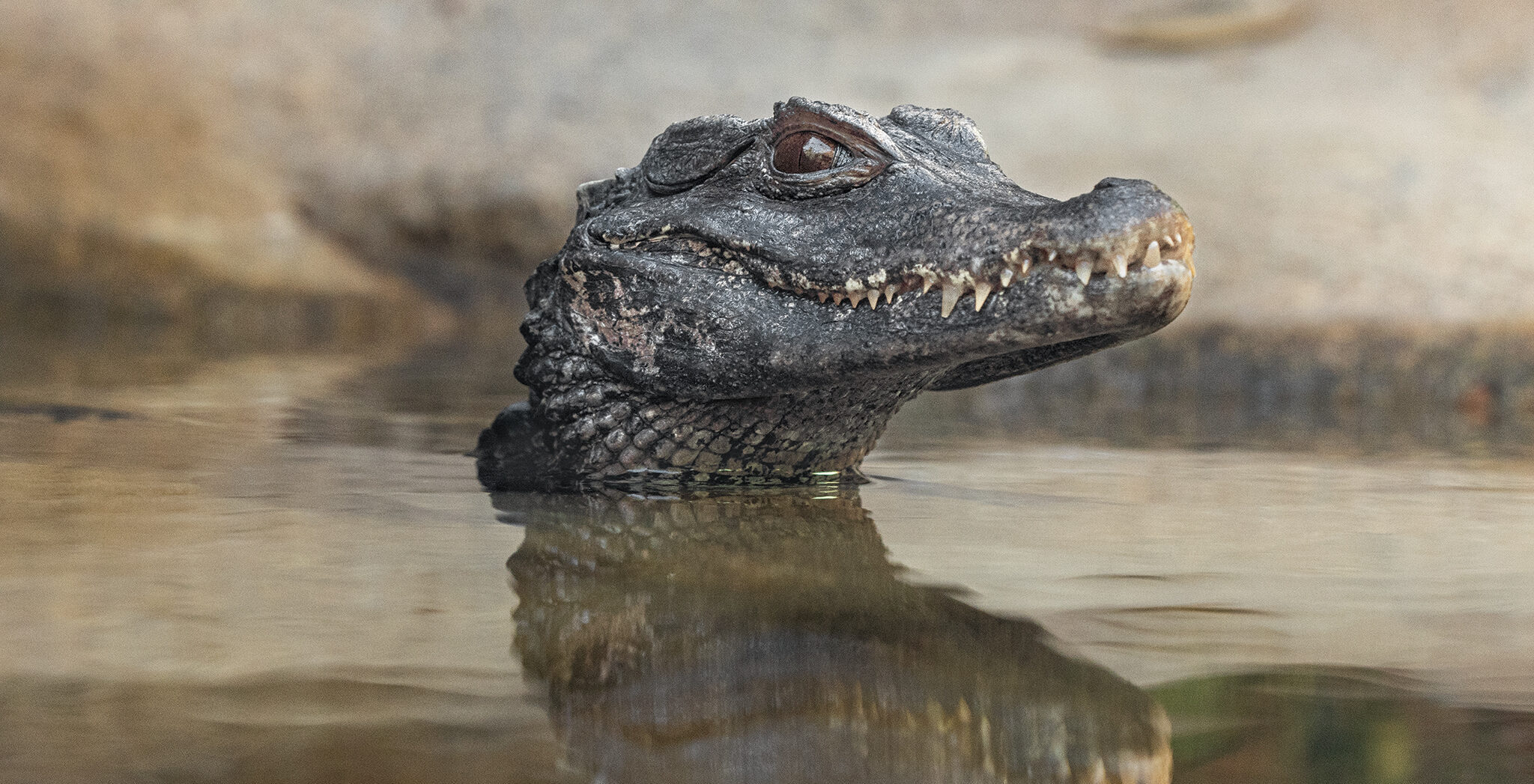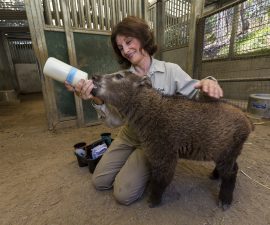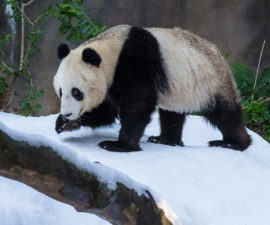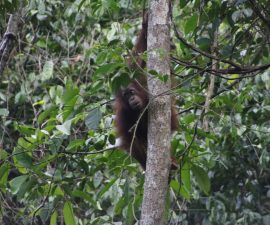BY Donna Parham
Diving into the Watery World
of Amazonia’s Caimans
It’s nighttime at the Stiefel-Behner Research Program at Cocha Cashu Biological Station in Peru’s Manu National Park. San Diego Zoo Wildlife Alliance scientist Adi Barocas, Ph.D., is slowly patrolling the shore of the oxbow lake in a (surprisingly small) inflatable boat. He’s in search of the Amazon’s largest predator: the black caiman Melanosuchus niger. “We travel along the banks with spotlights and scan the bank vegetation,” says Adi. “The red reflection of light in their eyes makes caimans visible to us in the darkness. Sometimes they dive or swim away with sudden movements and there is a splash,” which Adi admits “can be a little bit scary.” But, he says, “It’s exciting to find caimans—the larger ones especially impress me.” Black caimans were among the first reptiles studied at Cocha Cashu, and are part of the reason the biological station was founded there in 1969.
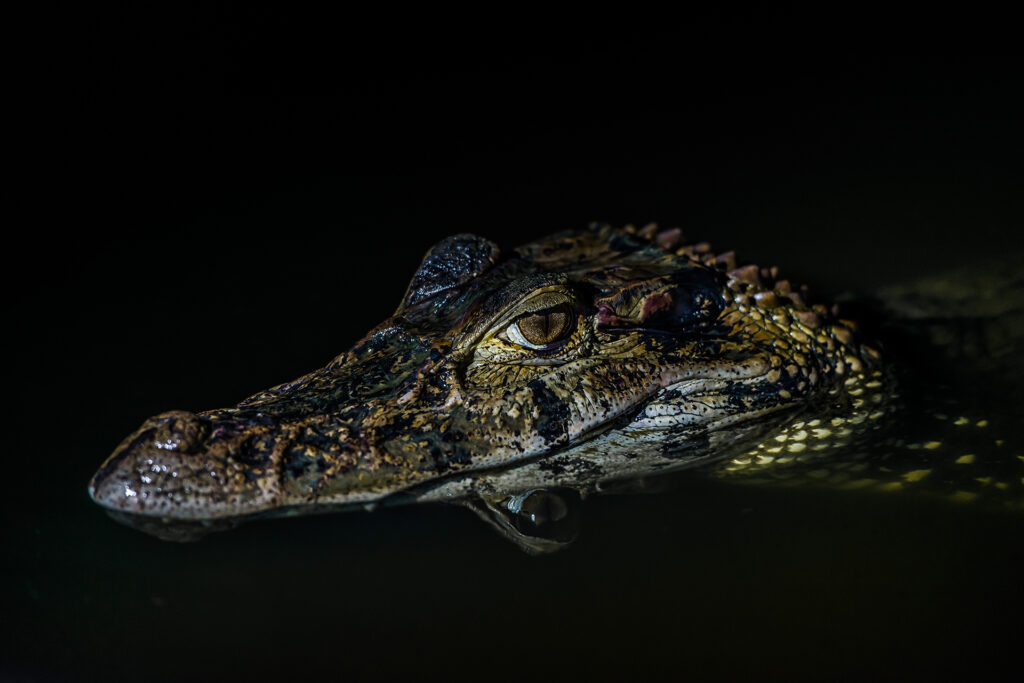
(Photo Credit | OSTILL/iStock/Getty Images Plus)
Cocha Cashu’s Caimans
Widely distributed throughout the Amazon Basin, black caimans can be more than 16 feet long—they’re the largest of the New World crocodilians. They hunt in the water and on land, emerging mostly at night. Large adults prey on fish and turtles, as well as capybaras and other mammals. Juveniles prey on small fish, frogs, and invertebrates. During the wet season, as the area floods, they have plenty of options for the kind of quiet waters they prefer. But in the dry season, they congregate in lakes and rivers. That makes Cocha Cashu prime habitat.
“Oxbow lakes are unique ecosystems, formed when rivers change their course,” says Adi. “Because the water in them is not commonly flowing, they are relatively productive ecosystems that have unique animal and plant communities. Oxbow lakes like Cocha Cashu have a high abundance of medium and large fish, which sustains stable populations of giant otters and black caimans.”
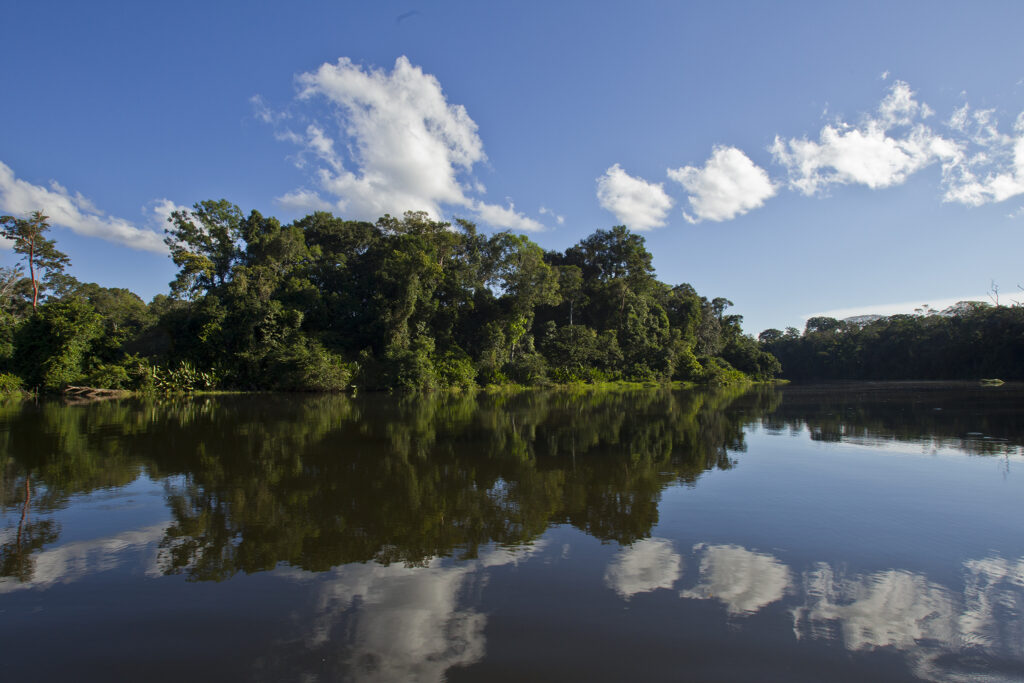
Once they spot a caiman, Adi estimates its size and records its location. “Black caimans are more active at night, which is why we study them during these hours,” says Adi. “Working in the oxbow lakes at night is more pleasant, because it’s not as hot as during daytime.” Adi’s team has been doing nighttime spotlight surveys in 22 oxbow lakes since 2019. “The idea is to estimate their abundance, and to find out what the best type of habitat for them is,” says Adi. “Our experience, so far, suggests that the abundance of large individuals is higher in protected area oxbow lakes without fishers and miners. We are also interested in black caiman interactions with giant otters, because these two species are the top carnivores in Amazon freshwater ecosystems.”
Caring for Caimans
Kim Gray, San Diego Zoo Wildlife Alliance curator of herpetology and ichthyology, is a member of the International Union for Conservation of Nature (IUCN) Crocodile Specialist Group, a network of experts working together to provide scientific advice to conservation organizations, government agencies, and other IUCN members. She has a special fondness for crocodilians. “I’ve always been fascinated by reptiles in general, and I think the crocodilians are beautiful,” she says. “They’ve been around for so very long, yet we’re still finding out amazing things about them—like they’re more closely related to birds than they are to other reptiles.” Kim and caimans go back a long way. At the age of 15, she cared for yacare caimans Caiman yacare at the Vancouver Aquarium. She first saw caimans in their native habitat when she traveled to the Amazon with her aquarium team members. More recently, Kim led a San Diego Zoo Wildlife Alliance Adventures expedition to Amazonia. At the Zoo, she oversees the team of wildlife care specialists who care for reptiles, including dwarf caimans Paleosuchus palpebrosus, in Jake’s Cool Critters at Wildlife Explorers Basecamp. At under six feet, the dwarf caiman is the smallest crocodilian.
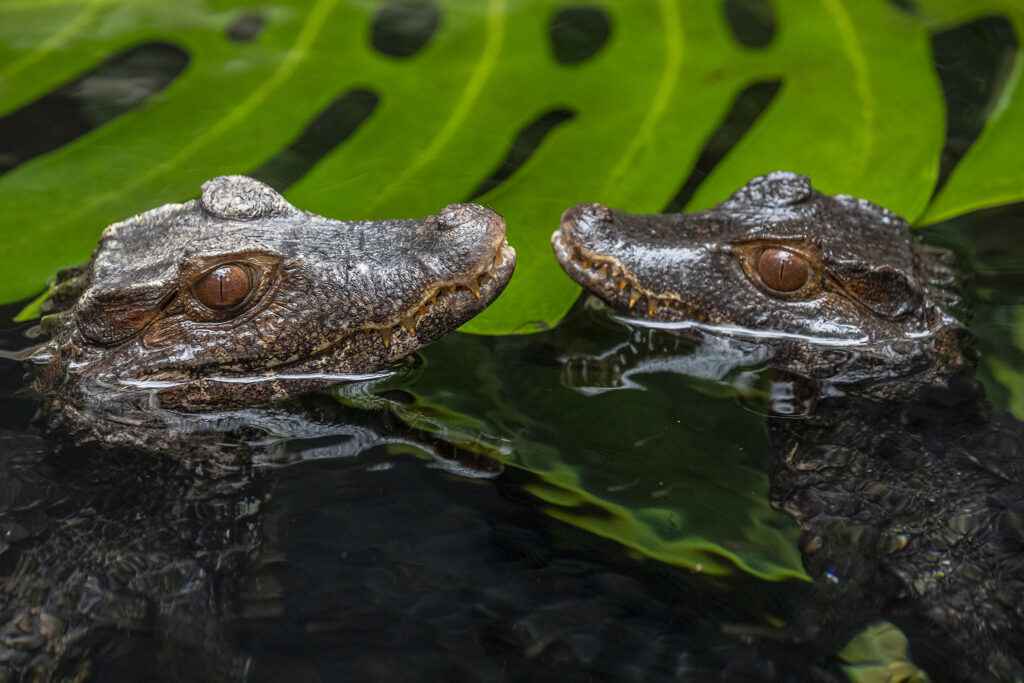
The order crocodilia includes three families: the crocodiles, the alligators, and the gharials. All 27 species share a similar—heavily armored—body plan: a large head with a long snout and toothy jaws, attached to a four-limbed, robust body and long, thick tail. Although some snakes can be longer, crocodilians are the largest living reptiles. Caimans, which live in Central and South America, are part of the alligator family, which also includes the American alligator. “Not every croc is a caiman, but every caiman is a croc,” explains Kim.
Caiman Concerns
While there has historically been heavy exploitation of caimans for their meat and especially their hides, caiman farms (for leather) have largely displaced poaching. But illegal wildlife trafficking is still a problem, as young caimans are targeted for the pet trade. Kim warns, “They don’t make good pets.” Eventually, owners of illegal caimans find that out for themselves. “Occasionally, we get calls from U.S. Fish and Wildlife, when they find a caiman in a pond or a park, to provide care or a home.”
Wildlife trafficking isn’t the only threat facing caimans. “Thinking about climate change, you wonder how it’s going to affect the populations,” says Kim. For crocodilians, as in many reptiles, temperature in the nest determines whether offspring will be male or female—a phenomenon known as “temperature-dependent sex determination.” In most crocodilians, high incubation temperatures produce males, and low temperatures produce females. “What happens if you have all males within a couple of generations?” This is the kind of question that those in the crocodilian conservation community want to be able to address.
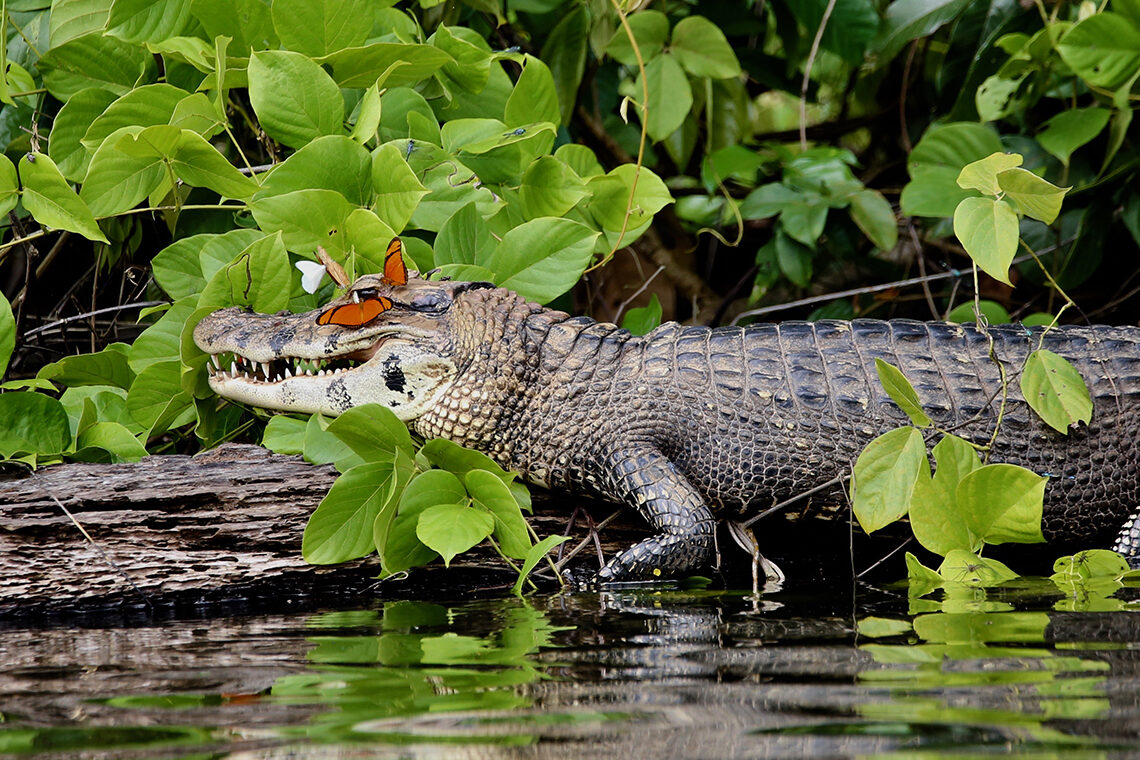
(Photo Credit | Adi Barocas, San Diego Zoo Wildlife Alliance)
Caimans and their crocodilian cousins charm many Zoo guests. “We’re fascinated by them, and we’re a little bit scared, yet there’s a certain affection,” says Kim. “The fact that crocodiles are mummified in Egyptian tombs shows this level of fascination, along with a sort of reverence.” At San Diego Zoo Wildlife Alliance, we are committed to keeping caimans around for a very long time. Studying caimans at the Zoo and in their native habitat helps us better understand them, and how to better protect them.
Not so Different, You and I
Crocodilians intrigue us, and we have more in common with these reptiles than you might think.
They care for their offspring.
Crocs are one of the few reptiles that protect their young until they are old enough to be on their own (almost two years for dwarf caimans). A mother crocodilian threatens or attacks predators that approach too closely. Care begins even before “mama croc” lays eggs, as she mounds up soil and vegetation to make a nest. As the biomatter decomposes, it heats the nest—like a compost pile—and helps keep the eggs warm. Mom settles in nearby to guard her eggs from predators—large birds, lizards, or raccoons—that might try to dig them up and eat them. When her eggs start to hatch, she sometimes gently uses her teeth to help her offspring out of their shells. Then, she carries hatchlings to the water in her mouth. Although juveniles can swim from the time they hatch, sometimes even older offspring get to ride on
mom’s back.
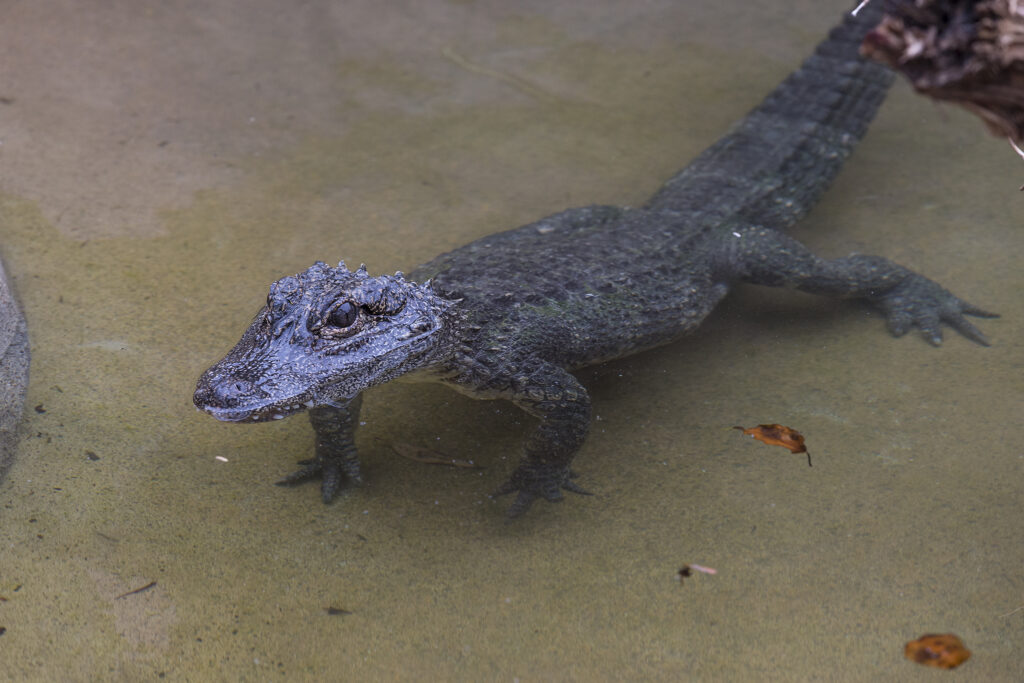
They communicate with each other.
Some croc vocalizations sound like rumbling thunder, grunts, barks, or chirps. “The parents, in particular the females, communicate with their offspring, even inside the egg,” says Kim. In fact, even before croc offspring hatch, they vocalize with each other and with their mother, as if to say, “Hey! I could use a little help here!” Like a human baby’s wail, the sound brings the mother running.
They are smarter than you might think.
Crocodilians are considered the most advanced of the living reptiles (meaning they are the least like the earliest reptiles). Wildlife care specialists teach them to approach separate stations for meals, examinations, and health care. They recognize individual people, and they respond to their own names. Kim shares another example. “Crocs are able to change their target mid-strike, something that other reptiles and amphibians can’t do. If a cobra or a lizard is going to strike at something, it is committed when it begins the strike. If the target moves out of the way, the cobra can’t change the strike path, whereas crocodilians can adjust—this shows a higher evolution of brain function.”
Discover how you’re making a difference for black caimans and other unique wildlife in this region through our Amazonia Conservation Hub.

